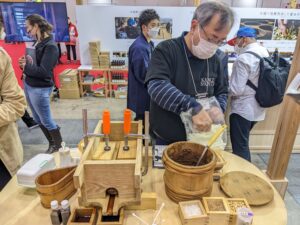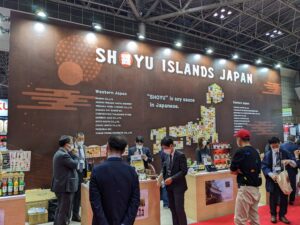After a three-year absence, FoodEx Japan, a giant trade show for the food industry, returned to Tokyo Big Site last week for four days, although unlike in the past, this time it was not open to the public (I had a press pass). I went on two days, which was almost enough time to see perhaps half of the exhibits. Over sixty countries had exhibits, with the non-Japanese exhibitors aiming to break into the Japanese market, or in some cases, expand, while the Japanese exhibitors seemed to be introducing new products or just there to have fun. After Japan, Italy and China and France had the biggest presence, while the six African nations present had for the most part just a single table each.
The first day there I was with my wife who was interested in tasting wine. I tried wines from Greece (a red), Italy, France, as well as some from Oregon. The most fun tasting came at the end of the day when I happened to stop by the Czech Republic area where there was sparkling wine being poured. While the sparkling wasn’t bad and the pours quite generous, it was how the bottles were being opened that really stood out; with a sword. Actually, it was a saber dull on the edges but with a sharp point. I had read about opening champagne bottles using a sword, or even a spoon, but I had never actually seen it done. But after a few seconds of instruction I was ready to try it. And it worked.

The saber method is quite simple. There is a seem running up and down one side of the bottle, up to the neck and the top. The wire holding the cork in place is loosened, but not removed. Then you simply slide the sword along the seam, and like shooting a hockey puck, you tap the top and it severs, leaving an uneven spout to pour from. And of course once the bottle was opened we had to consume the contents. The next day I saw one of the Czech guys open a bottle with a wine glass.
So many international food companies present, almost all of whom are not currently doing business in Japan. And this just two days after the Tokyo Marathon. It feels like a reopening of Japan to foreigners, although specific foreigners, (runners and food people), and not foreign tourists and travelers in general.
Toward the end of the first day my wife and I crossed the hallway and went into the Asian section to have a look around. The most interesting exhibits featured shōchū tasting (at least 100 different bottles of all kinds of shōchū as well as awamori) and a shōyu making demonstration where a rep from a coalition of small-scale shōyu makers (as opposed to the major brands) was squeezing shōyu out of very wet miso using a small wooden press. I didn’t realize it initially, but there were perhaps fifty different shōyu available for tasting. When I mentioned I like Shinshu shōyu from Nagano he went behind the table and selected five small bottles for me to take home, including his own product and two bottles of tamari.


The next day I started off in the Australia area. I was surprised there were so many whisky makers there; the number of distilleries has grown from something like fifty to 800 over the past twenty years. One table had products from Tazmania, including several whiskies and and gin and vodka from a sheep milk cheese making family that uses the spent whey as the base for fermenting. They even had aged vodka which was surprisingly good, considering I am not a vodka drinker, and only recently, and rarely, a gin fan.
One of the less eco products was water from Taiwan, each variety packed in hard plastic bottles. Such a waste of resources, including land fills.
All in all it was a great event. It’s good to have it back.